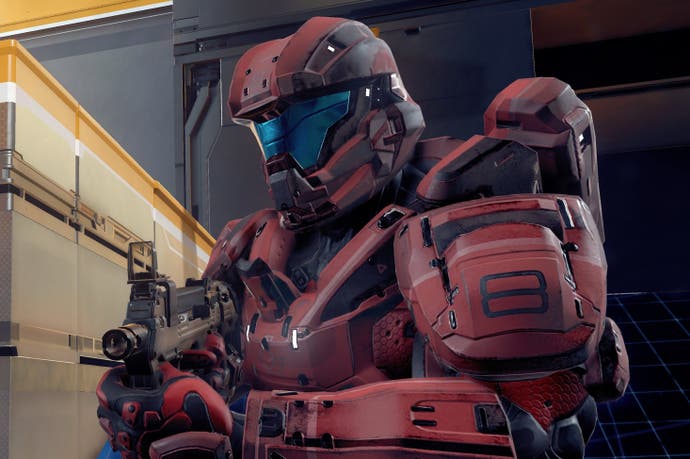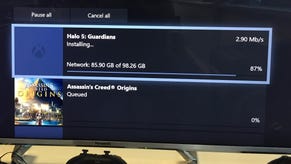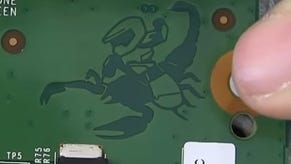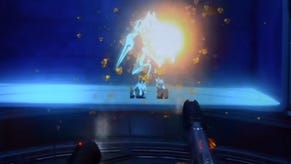Smart Scoping with Halo 5: Guardians' multiplayer beta
343 goes back to Halo's roots - with all mod cons.
The first time I played Halo 5: Guardians' competitive multiplayer it felt odd because I could zoom in and fire the Assault Rifle.
Ah, the Assault Rifle - the Mario of Halo's arsenal. The default gun, the classic all-rounder: good at close range, big clip, wide spread. And, in every Halo game, fired from the hip.
But in Halo 5: Guardians, 343 Industries' second Halo game and its first for the Xbox One, firing the Assault Rifle from the hip is no longer the only option. In Halo 5: Guardians, you can zoom in and use a scope for precise damage. What's going on?
343 calls it Smart Scope. Every gun in the game, the developers tell us, has it. That means you can zoom in on the Assault Rifle and all the other UNSC weapons I got to play with: the Magnum, the Battle Rifle, the DMR, the SMG, and, of course, the Sniper Rifle.
Let's remember that you've always been able to scope with the likes of the Pistol, the Battle Rifle, the DMR and the Sniper Rifle. But in Halo 5 Smart Scope makes this look a little different in that, visually, it's almost a Call of Duty-esque "aim down sights" animation.
But it's important to note that while Smart Scope looks like ADS, at the end of the day it acts like zooming in from past Halo games. So while there's more visual clutter on-screen, there's no penalty to mobility - a staple of Halo's run and gun gameplay for years.
So, you might be wondering, what's the point? Why add Smart Scope in the first place?
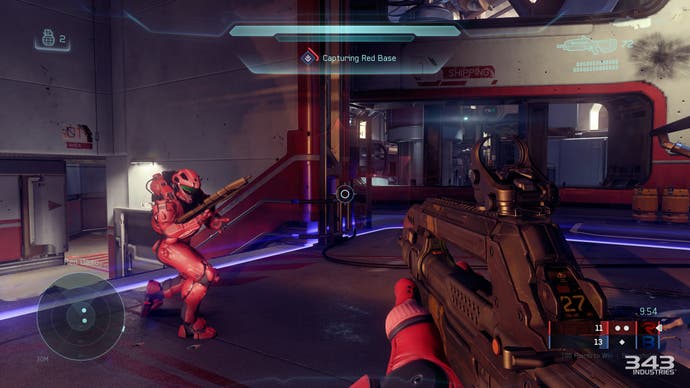
343 studio head Josh Holmes tells me the developers wanted to go "back to canon" by having a link between a Spartan's armour and their visor so they could provide extra information on the weapon they're holding. It's the "Smart Link" system that results in the "Smart Scope". Yes, it's kind of silly that a scope system has its own lore in a video game. But then, you know, video games.
When you get down to the brass tacks of gun play, when you're playing Slayer on Truth, Halo 5's version of Midship, and Spartans are firing at you from everywhere, you don't care about lore. You want to know whether to fire the Assault Rifle from the hip or use Smart Scope. 343 tells me Smart Scope does not affect damage output. That is, the damage of each bullet is the same. But it affects the spread of the bullets. So, if you're at a medium distance and you want to concentrate your fire, scoping with the Assault Rifle makes sense. But if you're up close, fire from the hip for a wider spread.
It takes a bit of getting used to, that's for sure. After playing Halo for years in pretty much the same way, PVP is as much about muscle memory as it is about strategy. It took me a few games to force my brain to realise that I could scope with the Assault Rifle, never mind whether I should. But after getting over the initial hump I found myself using Smart Scope a lot, targeting those Spartan visors.
Anyway, Smart Scope is a red herring on the search for innovation within Halo's refined arena gameplay. It will grab the headlines, for sure - in fact it already has - but Smart Scope didn't get in the way of my success on the battlefield. And in any case, descoping returns, so you can be knocked out of your zoom pretty easily. I feel it's important to note that I'm not trying to downplay the impact of Smart Scope here, because I've only played Halo 5 for a few hours, but at this early stage it feels balanced, which is a good thing.
It's the heightened mobility granted by the new Spartan Abilities that stood out for me. Chief among them is the Thruster Pack. This gives your Spartan a short but quick-fire boost in any direction, whether you're on the ground or in the air. Its use is restricted by a short cooldown, so you can't thrust across the entire map or dodge indefinitely, but you can dart about in a way you couldn't before.
Meanwhile, the new Clamber move rekindles memories of Splash Damage's Brink. If you jump in that classic floaty Halo fashion and come up close to a ledge, another press of the A button sees your Spartan clamber up. It helps get you where you want to be, and you can tell the maps have been designed with it in mind. Truth is Midship in all but name, so it feels less involved there, but on Empire, a map set atop a skyscraper in a city under siege, there are multiple levels to leap up to, nooks and crannies to explore and an increased sense of verticality with plenty of high ground to boot.
Let's talk about Sprint, which is a bone of contention among Halo fans. Halo 4 was heavily criticised by some for adding a Sprint. 343 wanted to keep it in but, mindful of that feedback, has tweaked it. Their solution is to block shields from regenerating while you're sprinting. It's an interesting idea that requires further play before casting judgement, but I did have to think twice about going after enemy Spartans immediately after I'd survived a close call. We'll all be hiding behind rocks, won't we?
The Thruster Pack, Clamber, Sprint and the new Slide combine to give the impression of a faster-paced game, but Halo 5 is the same speed, in essence, as Halo 4. It's just you can get to where you want to go quicker because getting there is easier. You can chain these moves together, for example jump, thrust forward then clamber, making it easier to escape, easier to hunt and easier to reach the action. There's a greater sense of urgency.

Expanding on the new movement options, 343 has come up with new offensive Spartan Abilities. The first is the Spartan Charge, which is triggered when you're sprinting at full pelt. Charge an enemy from the front or the side and you drop their shield, opening them up for a melee kill or maybe a hit from the powerful shotgun. Charge from behind, though, and it's a one-hit kill.
The Charge is satisfying but tricky to pull off as there doesn't appear to be a lock-on, unlike with the Prophet's Bane, Halo 5's version of the energy sword. I only managed to nail a charge a couple of times. Most of the time I flew past my target, embarrassingly, leaving myself open. But, again, I can image it'll be pretty devastating once you wrap your head around it, especially in close quarters maps.
Even harder to pull off is the Ground Pound. This new Spartan ability is performed from the air, so you jump, then charge up the Ground Pound which, when ready, slams you onto the floor. Strike a Spartan and it's a one-hit kill. There's splash damage, too.
It's tricky because while you're charging the Ground Pound you're a sitting duck. You're up there, in the air, proud in red or blue. You may as well paint a target on your Spartan's helmet head. Luckily, the charge isn't too long, but it's long enough to be shot out of the sky by mindful enemies with the Sniper Rifle.
I found it more useful to use the Smart Scope in mid-air. This automatically triggers your Thruster Pack for a brief bout of sustained flight, providing stability and time for precision fire. It doesn't last forever, but this maneuver, in combination with a weapon like the Battle Rifle or the DMR, is great for mid-distance headshots from anywhere on the map, really.
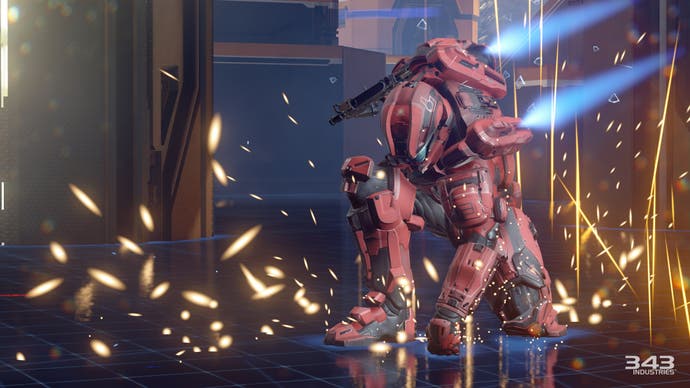
What 343 is going for here, with all these new Spartan Abilities, is an attempt to add a fourth chord to the cadence of Halo's combat. Over the years we've got used to the grenade, fire, melee rhythm of Spartan versus Spartan action. Importantly, all of the new Spartan Abilities are available from the off, which means, unlike Halo 4, players begin each match on a level playing field. This extends to weapons, too. Playing the game, it's legit. You believe it's all about skill. No perks. No unlocks. Dominate the power weapons and you have a good chance to win.
Outside of movement other changes are welcome, if a tad easy to forget. There's a new dynamic chatter system that sees Spartans talk to each other during a match. You hear things like "good kill," "taking fire" and "hostile on...". It's a cool addition designed to increase your mid-match awareness and simulate the idea of a team of soldiers working together using voice communication. But it's never going to replace actual communication over VOIP.
One of the lines you hear a lot is "30 seconds to...", which is one of the Spartans calling out the drop of a power weapon such as the Sniper Rifle or Prophet's Bane. The game offers more help here by layering a green symbol onto the HUD that shows where and when the power weapons will spawn. So, you can time your cycle through the map without having to mentally count between spawns, if you are so inclined.

It's funny; when you write down all that is new about Halo 5 multiplayer, it reads like a substantially different experience. But it felt familiar to me, almost safe. And I was satisfied that thought accurately and fairly summed up the Halo 5 PVP experience - until I played Breakout on Crossfire.
Breakout is a new round-based 4v4 mode that dragged me kicking and screaming out of my comfort zone. You have one life per round, so when you die you're out. First team to five rounds wins. The match begins with a short clip of all four of your Spartans running and leaping onto the battlefield, which is a nice touch. Immediately you notice there's no radar. No radar! And you notice the map, Crossfire, is a battlefield created with deadly sight lines in mind. This kind of mode isn't anything new when it comes to the FPS genre, of course, but it's a breath of fresh air for Halo. And it comes as no surprise to learn it's inspired by professional paintball.
Visually, Crossfire seems inspired by the VR missions from Metal Gear Solid. It's basic, but perfectly formed to add a layer of tension you don't normally get in standard run and gun Slayer. The battlefield is busy with cover, so it's hard to spot enemy players. This, though, works both ways, which is a good thing, because in Breakout shields are nerfed. You die quickly. Success demands communication - the in-game voice work does help, but again, it's no substitute for actual communication. And when you die you need to keep talking, too, as you follow the movements of your surviving teammates as they carefully hunt the enemy. You find yourself creeping around, hoping to spot a stray Spartan head pop out in between the angular structures. Do you risk using thrusters to survey the battlefield from mid-air, Halo 5's version of popping your head out from beneath the sand? Find an enemy. Kill it. It's 4v3. And so on. Until maybe it's 1v1, and you're the last Spartan standing, and it's all on you. If there's a play for eSports, it's here.
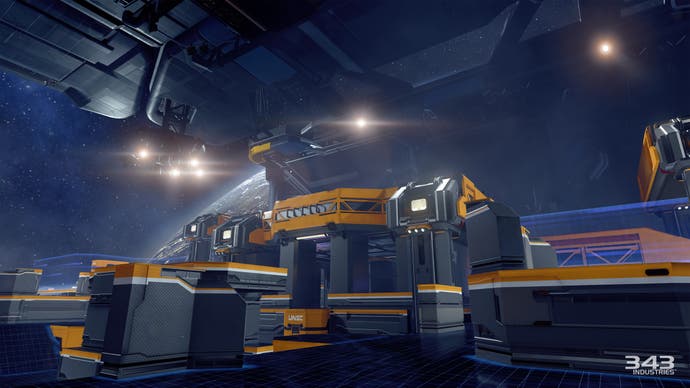
There will be those who say Halo 5 with its Thruster Pack is riffing off of Respawn's Titanfall, once dubbed Halo Killer, and Sledgehammer's Call of Duty: Advanced Warfare, both of which have movement boosts and all the rest. There's an element of this at play, I'm sure, but it's a part of a wider trend we're seeing as the FPS genre adapts to stay relevant. Plus, Halo had jet packs four years ago in Halo: Reach. So there.
Here's my impression after a few hours of play: 343 is trying to get the core back onside with Halo 5 while ensuring it has all mod cons. Halo returns to a level playing field while adding cosmetic iron sights. Halo returns to descoping while adding a Thruster Pack. It's a tricky balancing act, for sure, but I like what I've played. I was a tad worried that, bar Breakout, Halo 5 multiplayer is perhaps too familiar. But as the developers point out, we're only getting a glimpse of multiplayer here. There's more to Halo 5's PVP than arena.
And when the beta launches this December, it'll do so almost a year before the game proper comes out. That's very early, as far as Halo betas go. And it gives 343 plenty of time to react to feedback, which I have no doubt will be plenty and vociferous. After all, that Assault Rifle isn't going to design itself.
